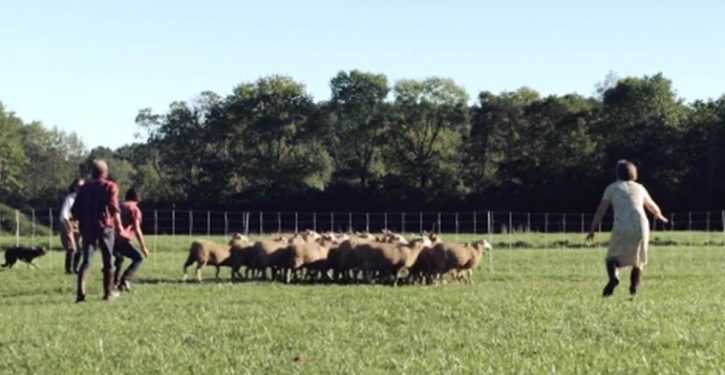
Oh, dear. Panties are in a wad at the New York Times, after the Washington Free Beacon’s Elizabeth Harrington revealed what taxpayers have spent to support dance performances of the conceptual-art piece “Doggie Hamlet,” the work of choreographer Ann Carlson (who looks like a nice lady).
Harrington summarized the performance with just the tiniest touch of, shall we say, unappreciative disdain:
The “conceptual art” features actors yelling and running at sheep in a field in Vermont.
Well, it’s so much more than that, but I’ll let you gain insight on that yourself here and here. There’s a lot to say – and I mean a lot – about “Doggie Hamlet.” But I think you’ll agree that the best thing you learn today is this priceless nugget from NYT reviewer Gia Kourlas (very much a “Doggie Hamlet” booster):
Will this presidential election be the most important in American history?
“Doggie Hamlet” also brings together people from seemingly disparate groups. Farmers, artists and, to her surprise, knitters have been in attendance. But this is what Ms. Carlson has done for years: taken choreography out into the real world, as when she made “Sloss, Kerr, Rosenberg & Moore,” a much-lauded dance for four lawyers, in 1986.
I hope, with as much sincere urgency as I’ve ever hoped anything in my life, that the U.S. taxpayer was funding “Sloss, Kerr, Rosenberg & Moore.”
That’s kind of the double-edged sword of public art funding. Do it, and you may get “Piss Christ.” Do it not, and you may miss out on a dance for four lawyers.
At any rate, here we have the official description of “Doggie Hamlet,” from Ann Carlson’s artist-roster page at Elsie Management (link above).
Doggie Hamlet is a full-length outdoor performance spectacle that weaves dance, music, visual and theatrical elements with aspects from competitive sheep herding trials. The work is performed by four dancers, one boy, one American Sign Language interpreter, two herding dogs and a flock of sheep in a 30 x 50 foot fenced field. Doggie Hamlet recalls the bucolic impression of a landscape painting or a 3D pastoral poem. The sheep, the dogs, the human performers, and the earth’s surface are at once performing as themselves and as living symbols in this work. Through story, motion, site and stillness Doggie Hamlet explores instinct, sentience, attachment, and loss, and is a beautiful and dreamlike spectacle weaving instinct, mystery, and movement into an unusual performance event.
“Sheep performance” jokes aside, “Doggie Hamlet” really has me thinking about an artistic proposal of my own.
Don’t worry. I’m an actual artist.* Avocational, to be sure. It’s just a hobby. But I’ve been told I’m not wasting my time.
The theme of non-linear insight from animal-involved performance (see Kourlas) is an intriguing one. There’s no reason I can think of why it should have to entail live action in pastoral fields. (To each her own, of course.) Visual imagery can convey every bit as much. My proposal, which still requires some shaping up (it’s about 15 minutes old at this point), is as follows:
Canine Enterprise is a full-spectrum visual experience weaving together imagery, music, cultural touchstones, and the emotive enjoyment of competitive recreation. The work presents dogs in a counterintuitive recreational setting, enhanced with arresting images of cultural icons like Elvis Presley, James Garner, and Kenny Rogers, executed in evocative non-traditional media such as velvet, and old T-shirts the artist still has from the 1980s. Downloading an image and photoshopping it conjures the impression of a transgressive post-modern perspective on artistic gravitas and spontaneous compulsion, inviting the viewer into a world of impertinent reflection, irony, transience, and poignant humor. Witnesses are seduced into recognition and the haunting power of memory by the Star Trek uniforms adorning the dogs, their arrangement around a sleek, astrophysically sterile table-structure on the Starship Enterprise, and the melancholy strains of “Maverick Didn’t Come Here to Lose.”
To realize this oeuvre, I will transform the image below. Bill to the taxpayer: $50,000. I dare you to say it’s not art.

* Really.




